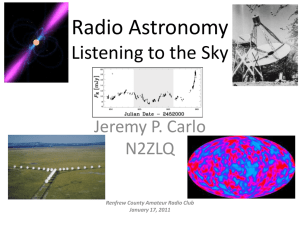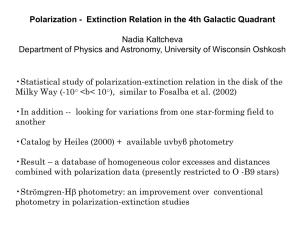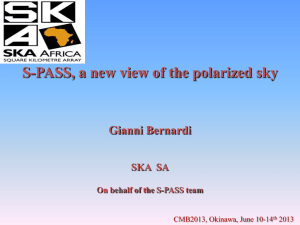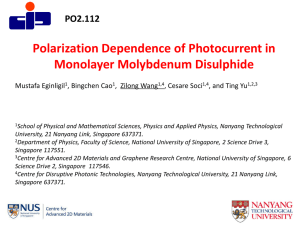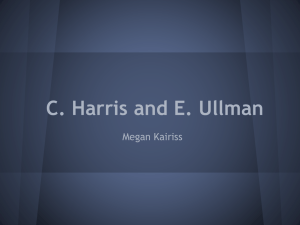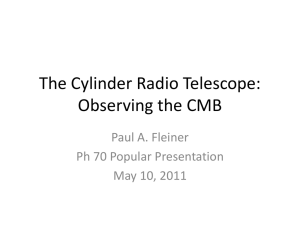Wideband Polarimetry with the Jansky Very Large
advertisement
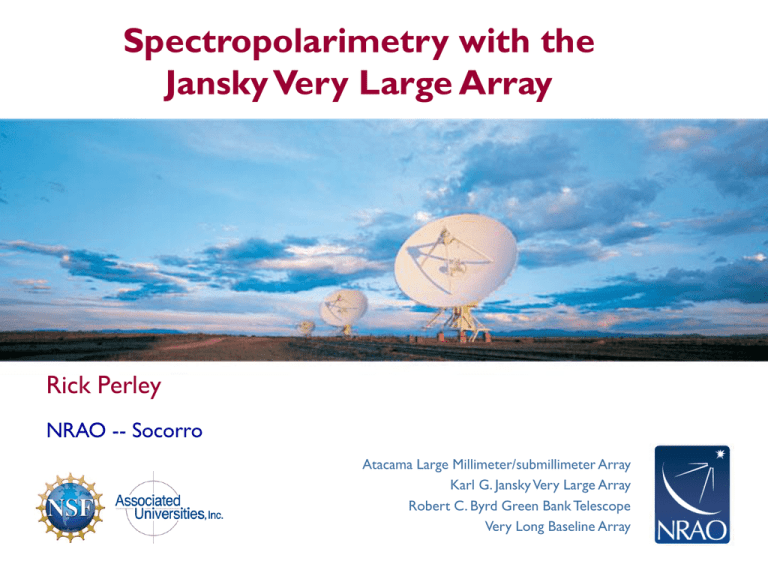
Spectropolarimetry with the Jansky Very Large Array Rick Perley NRAO -- Socorro Atacama Large Millimeter/submillimeter Array Karl G. Jansky Very Large Array Robert C. Byrd Green Bank Telescope Very Long Baseline Array Goals of This Presentation Jansky VLA • Introduce the Jansky Very Large Array (7 slides) – A major upgrade of the VLA • How does a radio interferometer do polarimetry? (9 slides) – Because all users should have at least a basic understanding of how their instruments work! • Show, by recent examples, the power, and the potential of the Jansky VLA for polarimetry of jets from AGN. (lots of slides) – Recent test data taken on Hercules A, and 3C273 provide excellent examples of what is to come. COST Meeting on Polarization and Active Galactic Nuclei 2 Jansky VLA The Very Large Array -- Overview • The Very Large Array is a 27-element, reconfigurable interferometer array, located in west-central New Mexico, USA. (lat = 34.1, long = 107.6). • High elevation (2100 m), desert climate (20 cm precip), means good observing conditions most of the year. • There are four major configurations, offering a range of over 300 in imaging resolution. – e.g. 1.5” – 400” at l=21cm • The original VLA, commissioned in 1980, has now been upgraded. • The new instrument – the Jansky Very Large Array, has hugely improved capabilities. COST Meeting on Polarization and Active Galactic Nuclei 3 Jansky VLA EVLA Project Overview • The EVLA Project is a major expansion of the Very Large Array. – The upgraded telescope is now called the Jansky Very Large Array. • Fundamental goal of the project: At least one order-ofmagnitude improvement in all observational capabilities, except spatial resolution. • The project began in 2001, and is now formally completed – on budget and on schedule. • Key aspect: A leveraged project, building on existing VLA infrastructure. – A sound strategy for these fiscally constrained times … COST Meeting on Polarization and Active Galactic Nuclei 4 Jansky VLA Major Goals for the VLA’s Upgrade • Full frequency coverage from 1 to 50 GHz. – Provided by 8 frequency bands with cryogenic receivers. • Up to 8 GHz instantaneous bandwidth – Provided by two independent dual-polarization frequency pairs, each of up to 4 GHz bandwidth per polarization. – All digital design to maximize instrumental stability and repeatability. • New correlator with 8 GHz/polarization capability – Designed, funded, and constructed by our Canadian partners, HIA/DRAO – Unprecedented flexibility in matching resources to science goals. • <3 mJy/beam (1-s, 1-Hr) continuum sensitivity at most bands. • <1 mJy/beam (1-s, 1-Hr, 1-km/sec) line sensitivity at most bands. • Noise-limited, full-field imaging in all Stokes parameters for most observational fields. – Requires higher level of software for calibration, imaging, and deconvolution. COST Meeting on Polarization and Active Galactic Nuclei 5 Jansky VLA Jansky VLA-VLA Capabilities Comparison The upgraded VLA’s performance is vastly better than the VLA’s: Parameter VLA EVLA Factor Current 10 mJy 1 mJy 10 2 mJy 0.1 GHz 8 GHz 80 8 GHz* # of frequency channels at max. BW 16 16,384 1024 16384* Maximum number of freq. channels 512 4,194,304 8192 131072 Coarsest frequency resolution 50 MHz 2 MHz 25 2 MHz Finest frequency resolution 381 Hz 0.12 Hz 3180 15.3 Hz 2 64 32 64* 22% 100% 5 100% Point Source Cont. Sensitivity (1s,12hr.) Maximum BW in each polarization # of full-polarization spectral windows (Log) Frequency Coverage (1 – 50 GHz) * New capabilities, now under testing, to be made available in Jan, 2013 COST Meeting on Polarization and Active Galactic Nuclei 6 Jansky VLA EVLA Project Status (Sept 2012) • Installation of new wideband receivers now complete at: – – – – 4 – 8 GHz (C-Band) 18 – 27 GHz (K-Band) 27 – 40 GHz (Ka-Band) 40 – 50 GHz (Q-Band) • Installation of remaining four bands completed late-2012: – – – – 1 – 2 GHz (L-Band) 23 now, completed end of 2012. 2 – 4 GHz (S-Band) 25 now, completed end of 2012. 8 – 12 GHz (X-Band) 20 now, completed end of 2012. 12 – 18 GHz (Ku-Band) 23 now, completed end of 2012. • In addition (but outside the Project), we are outfitting a new wideband low-frequency receiver (paid for by NRL). – Twelve systems now outfitted, the rest by early to mid 2013. COST Meeting on Polarization and Active Galactic Nuclei 7 Jansky VLA Ongoing VLA Developments • The formal project was completed on Sept 30 of this year. • Some construction items (receivers) continue until year’s end. • Software development and improvements (primarily for the more obscure correlator modes) will continue for many years. • Similarly, improvements in observing, calibration, and imaging methodologies will continue for years. • We strongly urge observers who wish to use the more sophisticated observational modes to come to Socorro, and spend ‘quality time’ with us! COST Meeting on Polarization and Active Galactic Nuclei 8 Jansky VLA How Does an Interferometer ‘Do Polarimetry’? • The goal is to obtain images of the sky brightness in the four Stokes’ parameters: I, Q, U, and V. • But an interferometer actually measures the (spatial) Fourier transform of the source emission. • Unfortunately, the interferometer cannot directly determine the corresponding visibilities. • So, how do we generate the complex visibilities corresponding to I, Q, U, and V? COST Meeting on Polarization and Active Galactic Nuclei 9 Stokes Visibilities Jansky VLA • Define the Stokes Visibilities I, Q, U, and V, to be the Fourier Transforms of the Stokes’ brightnesses: I, Q, U, and V: • Then, the relations between these are: • I I, Q Q, U U, V V • Stokes Visibilities are complex functions of the spatial baseline components (u,v), while the Stokes Images are real functions of the angular sky coordinates (l,m). • Our task is now to obtain these Stokes visibilities from the cross-power measurements provided by an interferometer. • So … what does the interferometer actually provide? COST Meeting on Polarization and Active Galactic Nuclei 10 Jansky VLA Antennas are Polarized! • Polarimetry is possible because antennas are polarized – their output is not a function of the total intensity, I, alone. • It is highly desirable (but not required) that the two outputs be sensitive to two orthogonal modes (i.e. linear, or circular). A generic antenna LCP Polarizer RCP • In interferometry, we have two antennas, each with two differently polarized outputs. • We can then form four complex correlations. • What is the relation between these four correlations and the four Stokes’ parameters? COST Meeting on Polarization and Active Galactic Nuclei 11 Four Complex Correlations per Pair of Antennas • Two antennas, each with two polarized outputs, produce four complex correlations. • What is the relation between these four correlations, and the four Stokes parameters? Jansky VLA Antenna 1 Antenna 2 (feeds) R1 L1 R2 (polarizer) L2 (signal transmission) X X RR1R2 RR1L2 X X RL1R2 RL1L2 (complex correlators) Four complex cross-products COST Meeting on Polarization and Active Galactic Nuclei 12 Jansky VLA Relating the Products to Stokes’ Visibilities • Let ER1, EL1, ER2 and EL2 be the complex representation (phasors) of the RCP and LCP components of the EM wave which arrives at the two antennas. • We can then utilize the definitions earlier given to show that the four complex correlations between these fields are related to the desired visibilities by (ignoring gain factors): RR1R 2 E R1 E R* 2 (I V ) / 2 RL1L 2 E L1 E L* 2 (I V) / 2 RR1L 2 E R1 E L* 2 (Q iU) / 2 RL1R 2 E L1 E R* 2 (Q iU) / 2 • So, if each antenna has two outputs whose voltages are faithful replicas of the EM wave’s RCP and LCP components, then the simple equations shown are sufficient. COST Meeting on Polarization and Active Galactic Nuclei 13 Solving for Stokes Visibilities Jansky VLA • The solutions are straighforward: I RR1 R 2 RL1 L 2 VR R QR R R1 R 2 R1 L 2 L1 L 2 L1 R 2 U i ( R R1 L 2 R L1 R 2 ) • For an unresolved, or partially resolved source, Q, U, and V are much smaller than I (low polarization). • Thus, the amplitudes of the cross-hand correlations are often much less than the parallel hand correlations. • V is formed from the difference of two large quantities, while Q and U are formed from the sum and difference of small quantities. • If calibration errors dominate (and they often do), the circular basis favors measurements of linear polarization. COST Meeting on Polarization and Active Galactic Nuclei 14 Jansky VLA Summary: Interferometric Polarimetry (made easy) • So, (in principle) the process is easy: 1. 2. 3. 4. 5. 6. 7. 8. Collect all four cross-correlations from your interferometer. Calibrate! Generate the four Stokes visibilities from your four correlations. Fourier transform all four. Deconvolve all four. Combine to form polarization and position angle images. Think hard, analyze, etc. Write it up, and publish! COST Meeting on Polarization and Active Galactic Nuclei 15 Jansky VLA But The Real World is harder … • The preceding description presumes: 1. 2. 3. Antennas fixed to the sky frame (no parallactic angle rotation) Perfectly polarized antennas Perfectly calibrated data. • Sadly, none of these things happens in the real world. • The first issue is not a problem – a simple extension of the theory handles the issue. • Real antennas are imperfectly polarized – some RCP power emerges from the LCP port, and vice versa. • In the limited time available, there can be no description of how we manage with the inevitable imperfections. • In brief: excellent methods exist, but improvements are needed! COST Meeting on Polarization and Active Galactic Nuclei 16 Jansky VLA Illustrative Example – Emission from Mars. • The planet Mars radiates as a blackbody, with a brightness temperature near 200 K. • Due to the change in refractive index between the Martian surface and the atmosphere, the (unpolarized) emerging radiation becomes partially linearly polarized upon passing through the interface – increasingly so as the angle increases. • The observable effect is that emission away from the center of the planet becomes increasingly linearly polarized, with the direction directed radially away from the center. • I show next some I, Q, U data of Mars taken at 23 GHz in April 1999, while the VLA was in its most compact configuration. (Resolution is about 4 arcseconds). COST Meeting on Polarization and Active Galactic Nuclei 17 Jansky VLA Martian Visibility Functions (I, Q, U) I Q U COST Meeting on Polarization and Active Galactic Nuclei 18 Jansky VLA The Corresponding Images: Mars I • • • • • • Q U P Mars emits in the radio as a black body. Shown are false-color coded I,Q,U,P images from Jan 2006 data at 23.4 GHz. V is not shown – all noise – no circular polarization. Resolution is 3.5”, Mars’ diameter is ~16”. From the Q and U images alone, we can deduce the polarization is radial, around the limb. Position Angle image not usefully viewed in color. COST Meeting on Polarization and Active Galactic Nuclei 19 Jansky VLA Mars – A Traditional Representation • Here Q, and U are combined to make a more realizable map of the linearly polarized emission, and its position angle. • The dashes show the direction of the E-field. • The dash length is proportional to the polarized intensity. • COST Meeting on Polarization and Active Galactic Nuclei 20 Jansky VLA Recent Polarimetry with the VLA • Much effort is now going into commissioning the upgraded VLA. • The enormous rises in observational capabilities is accompanied by a similar rise in the challenges in the data calibration and imaging process. • I show here some recent results arising from observations of Hercules A, and 3C273. COST Meeting on Polarization and Active Galactic Nuclei 21 Hercules A • • • • (Perley and Cotton, demo) Jansky VLA z = 0.154, radio galaxy. D = 710 Mpc, 1arcsec = 3.4 Kpc. 4-9 GHz color-code spectro-intensity image (redder = older). 1 Kpc resn. EVLA data: 1 through 9 GHz, all four configurations, 1Kpc resolution. Shocks in western lobe indicate repeated ejection. COST Meeting on Polarization and Active Galactic Nuclei 22 Jansky VLA Hercules A (3C348) Polarized Intensity • l = 3.5 cm, Resolution = 0.3 arcseconds COST Meeting on Polarization and Active Galactic Nuclei 23 Jansky VLA Western Lobe • Repeated ejections, each highly polarized, clearly visible. COST Meeting on Polarization and Active Galactic Nuclei 24 Jansky VLA Eastern Lobe • This side is much more chaotic in appearance. COST Meeting on Polarization and Active Galactic Nuclei 25 Jansky VLA Hercules A – Eastern Lobe, closeup. COST Meeting on Polarization and Active Galactic Nuclei 26 Jansky VLA 3C273 – a prominent QSO with a strong jet. • 3C273 has a strong jet and a weak ‘halo’ • Shown here is a low resolution (4 arcsec.) image at 22 cm wavelength. • There is a very strong onesided jet, but no counter-jet. • A weak, diffuse halo is seen. COST Meeting on Polarization and Active Galactic Nuclei 27 Jansky VLA 3C273: Overview from VLA data • The jets at 1 arcsecond resolution. • l = 2cm l = 3.6 cm (with Poln.) COST Meeting on Polarization and Active Galactic Nuclei 28 Jansky VLA The Remarkable Inner Jet: • The inner jet at 0.4 arcsec. resolution. • The central nucleus has been removed to show the continuity of the jet to the smallest angular scales. • There is no hint of expansion in the jet prior to its entry to the ‘outer’ jet region. • There is no sign of a counterjet. COST Meeting on Polarization and Active Galactic Nuclei 29 Jansky VLA High-resolution structure. • Inner and outer jets, at 0.125 arcsecond resolution. • VLA data, at 14.965 MHz frequency. • Key point: About 6 hours’ data with all VLA configurations. COST Meeting on Polarization and Active Galactic Nuclei 30 Jansky VLA New Observations from the Jansky VLA • As part of commissioning, we observed 3C273 with the full 8 GHz bandwidth. • Here we show the results at 19 GHz, using just 75 minutes’ observation, and a single 128 MHz-wide subband. There are 63 others … DR – about 250,000:1 COST Meeting on Polarization and Active Galactic Nuclei 31 The outer jet at 19 GHz Jansky VLA • Outer jet … with 100 milliarcsecond resolution … • Even with only a single configuration, a single subband, and only 75 minutes integration, the outer jet is seen with much better sensitivity than our previous work, using 6 hours integration and four configurations! COST Meeting on Polarization and Active Galactic Nuclei 32 Jansky VLA Close-up View of the Outer Jet COST Meeting on Polarization and Active Galactic Nuclei 33 Jansky VLA Polarization in the outer jet. • Polarization is seen easily in the outer jet. • Magnetic field orientations are as expected. • However … no polarization seen in the inner jet. • Problem is mostly due to calibration issues. COST Meeting on Polarization and Active Galactic Nuclei 34 Jansky VLA A Summary • The upgraded Jansky Very Large Array is ready for serious usage. • The full 8 GHz-wide, full polarimetric modes are working. • These new capabilities offer unprecedented sensitivity and imaging/polarimetric performance for the study of astrophysical jets, and other objects. COST Meeting on Polarization and Active Galactic Nuclei 35 The National Radio Astronomy Observatory is a facility of the National Science Foundation operated under cooperative agreement by Associated Universities, Inc. www.nrao.edu • science.nrao.edu
